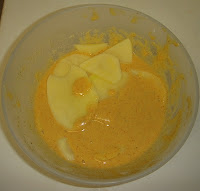Serves: 4; Preparation time: 45 minutes including preparing the ingredients and cooking
Ingredients:
2 lbs Dondakayalu (Kundru, Ivy gourd)- washed, dried and sliced
Salt to taste
A spice mix of:
1 tsp Cumin powder (
Jheera,
Jilakara)
1 tsp Coriander powder (
Dhania)
1 tablespoon desiccated coconut powder (
Copra)
Red chilli powder to taste
1 tsp Sugar
1/2 tsp Dry mango powder (
Amchur)
Tempering:
Oil 1 tsp or 3 tbsps
0.5 tsps Mustard seeds (
Avalu,
Rai)
0.5 tsps Cumin seeds (
Jilakara,
Jheera)
0.5 tsps Turmeric powder (
Pasupu,
Haldi)
0.5 tsps Asafoetida (
Inguva,
Heeng)
Method:
There are two ways of preparing this dish: Steamed with less oil for the health conscious; Fried with lot of oil for the food lovers.
1. Heat oil in a saucepan (1 tsp is enough for a steamed dish. Take upto 3 tablespoons if frying.)
2. Add mustard seeds. When they crackle, add Cumin seeds, turmeric powder, asafoetida. (Omit mustard seeds and cumin seeds from the recipe if frying as they get burnt during frying process.)
3. Add the ivy gourd slices to this tempering.
4. If you're steaming them, sprinkle upto 1 tablespoon of water and cover. If you're frying, no need to add water.
5. Uncover and stir every 5 minutes so that they are evenly cooked.
6. It may take upto 15 minutes for the vegetable to soften. Add salt when almost done. Frying takes even longer, fry until the slices turn dark brown, keep the pan uncovered during the final stages of frying. Drain any excess oil when done with frying.
7. When the vegetable is cooked, add the spice mix (red chilli powder, sugar, coconut/Coriander/Cumin/Dry mango powders). Cook for 3 minutes and turn off the heat. Serve with rice.
Precautions/Variations/Notes:
For fried ivy gourd, it comes out best if the gourds are thinly sliced into rounds, thereby exposing more surface area for frying. However, this takes lot of time. Steaming is a much faster healthier (and not as tasty) process, and the gourds can be cut into thicker rounds or even quartered into fours lengthwise.
Traditional cooks advise to discard any ripe red fruit, but I love the ripe red ones too, they have a unique flavour that I find so yummy when fried.
Kalyan annaya suggests: Add some fine chopped onions & green chillies in the fry, omit the Copra powder/red chilli powder, makes for a yummy variation.
Sometimes I add a tablespoon of minced tomatoes to the salt-spices-sugar, let it marinate for 15 minutes and mix it into the almost-done fry, I omit the
Amchur. Like I always believe, follow your heart!
Health benefits:
Coccinia grandis is rich in fiber and beta-carotene. It is an excellent food for diabetic people as it has a low Glycaemic Index. That is, it takes a lot of time for our body to digest and break down into carbohydrate sugars and finally absorb it into our bloodstream.
Culture & Trivia:
My favourite, Krishna's favourite, Kaavya's favourite. Are there any more fans out there? I love you
Dondakaya!
Also called Gentleman's toes, in contrast with Lady's finger. Interestingly, the names rhyme even in Telugu,
Dondakaya and
Bendakaya!
Krishna tells me of a belief that consuming
dondakaya makes one dumb, whereas consuming
bendakaya (Lady's finger) makes one bright. Rest assured my darling
dondakaya fans, it won't make us dumb, it's actually very good for health. Also, this vine grows upto 4 inches a day, very easy to propagate, mammoth task to get rid of as a weed, so it should signify speed & perseverance, not slow dumbness! Dear
dondakaya, how you have been mislabeled by some, I am here to redeem you ;-)
































